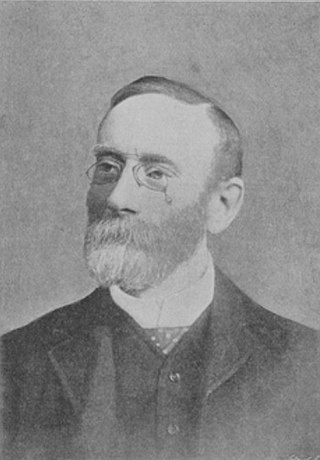Related Research Articles

The Ulster Museum, located in the Botanic Gardens in Belfast, has around 8,000 square metres of public display space, featuring material from the collections of fine art and applied art, archaeology, ethnography, treasures from the Spanish Armada, local history, numismatics, industrial archaeology, botany, zoology and geology. It is the largest museum in Northern Ireland, and one of the components of National Museums Northern Ireland.

John Templeton (1766–1825) was a pioneering Irish naturalist, sometimes referred to as the "Father of Irish Botany". He was a leading figure in Belfast's late eighteenth century enlightenment, initially supported the United Irishmen, and figured prominently in the town's scientific and literary societies.

William Henry Harvey, FRS FLS was an Irish botanist and phycologist who specialised in algae.
William McCalla (1814–1849) was an Irish naturalist.
The history of phycology is the history of the scientific study of algae. Human interest in plants as food goes back into the origins of the species, and knowledge of algae can be traced back more than two thousand years. However, only in the last three hundred years has that knowledge evolved into a rapidly developing science.

Robert Ball was an Irish naturalist. He served as the Director of the Dublin University Museum, and developed a method of dredging known as "Ball's dredge." He served as a secretary to the Royal Zoological Society of Ireland for two decades and was responsible for popularizing natural history through public educational outreach.
James Motley was a Yorkshireman closely associated with South Wales and Borneo.

George Edward Massee was an English mycologist, plant pathologist, and botanist.

William Hincks was an Irish Unitarian minister, theologian and professor of natural history. He was the first professor of natural history at University College, Toronto and president of the Canadian Institute. He was also the first editor of the Unitarian magazine The Inquirer.

Anne Elizabeth Ball (1808–1872) was an Irish botanist, amateur algologist, and botanical illustrator. Born in Cobh 1808, Ball was a sister of naturalist Robert Ball (1802–1857) and zoologist Mary Ball (1812–1898). The siblings became interested in natural history through the passion of their father, Bob Stawell Ball.

David Moore was a Scottish botanist who served as director of the Irish National Botanic Gardens for over 40 years.

Matilda Cullen Knowles is considered the founder of modern studies of Irish lichens following her work in the early twentieth century on the multi-disciplinary Clare Island Survey. From 1923 she shared curatorship of the National Museum of Ireland herbarium – a collection of dried and pressed plants now housed at the National Botanic Gardens. Her work is said to have "formed an important baseline contribution to the cryptogamic botany of Ireland and western oceanic Europe".
Mary J. P. "Maura" Scannell (1924–2011) was a leading Irish botanist.
Alexander Carte MD, FRCSI, MRIA was an Irish zoologist and palaeontologist and was first director Natural History Museum, Dublin.
Robert Bell was a Northern Irish riveter with Harland and Wolff and amateur geologist, mineral and fossil collector. He was described by Robert Lloyd Praeger as "the working-man naturalist."
Mary Johnston(e) Lynn was an Irish botanist known for her phyto-ecological studies in Northern Ireland.

Thomas Vincent Campbell was a physician, missionary and an entomological collector in India. He helped establish sanatoria for tuberculosis treatment in Madanapalle, a hospital in Jammalamadugu which is now named after him, and the Ralph Wardlaw Thompson memorial hospital at Chikkaballapur and was awarded a Kaiser-i-Hind for his contributions to the health of the poor. His collections of Hemiptera from India resulted in the descriptions of many new species of bug, several of which were named after him.

William Howard Campbell was an Irish Presbyterian missionary who worked with the London Missionary Society in southern India. He worked in Jammalamadugu in Cudappah District. He was also a naturalist with a keen interest in birds and moths. The Campbell Memorial School founded in Jammalamadugu in 1913 was named in his memory. The Northern Ireland MP, Sir David Callender Campbell was one of his sons.
Margaret Constance Helen Blackler (1902–1981) was a British phycologist, botanical collector and museum curator.

Arthur Wynne Foot was an Irish doctor, professor of medicine, and an entomologist.
References
- 1 2 3 4 Praeger, R. Lloyd. "Some Irish Naturalists: A Biographical Note-book". National Botanic Gardens of Ireland. Archived from the original on 23 January 2015. Retrieved 30 December 2020.
- ↑ Irwin, Clarke Huston (1912). "Campbell, William Howard". Dictionary of National Biography, supplement. pp. 301–302.
- ↑ Desmond, Ray (1994). Dictionary of British and Irish Botantists and Horticulturalists Including Plant Collectors, Flower Painters and Garden Designers (2nd ed.). Milton: Taylor & Francis Group. p. 125. ISBN 9781000162868.
- ↑ McMillan, N. F.; Morton, O. (1979). "A Victorian Album of Algae from the North of Ireland with Specimens Collected by William Sawers". The Irish Naturalists' Journal. 19 (11): 384–387. ISSN 0021-1311. JSTOR 25538300 . Retrieved 30 December 2020.